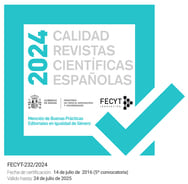La neurohermenéutica de la sospecha. Una aproximación teórica
Resumen
Este artículo revisita la hermenéutica de la sospecha de Paul Ricœur considerándola un acto de interpretación inquisitivo basado en la intersubjetividad y destinado a desvelar significados ocultos y latentes del texto literario. En nuestra opinión, el marco teórico de Ricœur es relevante para los estudios neurocognitivos actuales aplicados a la literatura en cuanto a las cuestiones de encarnación (embodiment), simulación corporal e interpretación de significados textuales latentes y ocultos tras los evidentes. La práctica de la sospecha de Ricœur supone uno de los dos polos de nuestra investigación actual del texto literario, siendo el segundo la aproximación neurohermenéutica. Desde la perspectiva de lo que aquí definimos como la neurohermenéutica de la sospecha, el lector se convierte en intérprete y cuestiona el texto y los distintos niveles de sus rasgos superficiales cuando advierte claves inferenciales destacadas que desvelan significados secundarios. El proceso de construcción del significado depende de un acto creativo acaecido en la imaginación del lector, que encarna la (re-)construcción mental de la situación descrita en el texto. Por tanto, la interpretación de la sospecha no se apoya en el texto, el autor, el lector o el contexto cultural o cognitivo, sino en una relación compleja y dinámica que pivota alrededor de las facultades encarnadas comunes a todo ser humano. Proponemos que Ricœur, especialmente en las derivas postcríticas de la actualidad, puede resultar de gran ayuda para redefinir el placer de descifrar los mundos ficticios de la literatura en tanto que pone a prueba al lector para ‘jugar’ con el texto literario, concebido como una terra incognita de múltiples e inagotables significados.
Citas
ABRAMO, Federica, Renata GAMBINO & Grazia PULVIRENTI (2017): «Cognitive Literary Anthropology and Neurohermeneutics. A Theoretical Proposal». Enthymema, 8, 44-62.
CUCCIO, Valentina, Marco CARAPEZZA & Vittorio GALLESE (2013), «Metafore che ri-suonano. Linguaggio e corpo tra filosofia e neuroscienze». EC. Rivista dell’Associazione Italiana Studi Semiotici, 7:17, 69-74.
CUPCHIK, Gerald (1994): «Emotion in Aesthetics: Reactive and Reflective Models». Poe-tics, 23, 177-188.
DIERCKXSENS, Geoffrey (2018): «Imagination, narrativity and embodied cognition: Exploring the possibilities of Paul Ricœur’s hermeneutical phenomenology for enactivism». Filosofia Unisinos, 19:1, 41-49.
FELSKI, Rita (2009): «After Suspicion». Profession, 28-35.
FELSKI, Rita (2011): «Suspicious Minds». Poetics Today, 32:2, 215-234.
FELSKI, Rita (2015): The Limits of Critique. Chicago, University of Chicago Press.
FREEDBERG, David & Vittorio GALLESE (2007): «Motion, Emotion and Empathy in Aesthetic Experience». Trends in Cognitive Sciences, 11:5, 197-202.
FREEMAN, Margaret (2007): «Cognitive Linguistic Approaches to Literary Studies. State of the art in Cognitive Poetics», in D. Geeraerts & H. Cuyckens (eds.), The Oxford Handbook of Cognitive Linguistics. Oxford/Nueva York, Oxford University Press, 1175-1202.
GADAMER, Hans-Georg (1984): «The Hermeneutics of Suspicion». Man and World, 17, 313-323.
GALLESE, Vittorio et al. (1996): «Action Recognition in the Premotor Cortex». Brain, 1996, 119, 593-609.
GALLESE, Vittorio (2013): «Corpo non mente. Le neuroscienze cognitive e la genesi di soggettività e intersoggettività». Educazione sentimentale, 20, 8-24.
GALLESE, Vittorio (2016): «Finding the Body in the Brain. From Simulation Theory to Embodied Simulation», in B. McLaughlin & H.K. Kornblith (eds.), Goldman and His Critics. Hoboken, John Wiley & Sons, 297-314.
GALLESE, Vittorio (2017): «Visions of the Body: Embodied Simulation and Aesthetic Experience». Aisthesis, 1, 1, 41-50.
GALLESE, Vittorio (2018a): «Embodied Simulation and its Role in Cognition». Reti, sa-peri, linguaggi, 7:1, 31-46.
GALLESE, Vittorio (2018b): «The Problem of Images: A View from the Brain-Body». Phenomenology and Mind, 14, 70-79.
GALLESE, Vittorio (2018c): «Naturalizing Aesthetic Experience. The Role of (Liberated) Embodied Simulation». Projections, 12:2, 50-59.
GALLESE, Vittorio & Valentina CUCCIO (2015). «The Paradigmatic Body - Embodied Simulation, Intersubjectivity, the Bodily Self, and Language», in T. Metzinger & J. M. Windt (eds.), Open MIND, Fráncfort del Meno, MIND Group, 1-22.
GAMBINO, Renata & Grazia PULVIRENTI (2018): Storie, menti, mondi. Approccio neuroermeneutico alla letteratura. Milán, Mimesis.
GAMBINO, Renata & Grazia PULVIRENTI (2019): «Neurohermeneutics. A Transdiscipli-nary Approach to Literature». Gestalt Theory, 41:2, 185-200.
GARVIN, Paul (1964): A Prague School Reader on Esthetics, Literary Structures and Style, Washington D.C., Georgetown University Press.
GOLDMAN, Susan, Kathryn MCCARTY & Candice BURKETT (2015): «Interpreting Infer-ences in Literature», in E.J. O’Brien, A.E. Cook & R.F. Lorch Jr. (eds), Inferences during Reading. Cambridge, Cambridge University Press, 386-415.
GRAESSER, Arthur C. & Rolf A. ZWAAN (1995): «Inference Generation and the Construction of Situation Models», in C.A. Weaver, S. Mannes & C.R. Fletcher (eds.), Discourse Comprehension: Essays in Honour of Walter Kintsch. Nueva York-Londres, Routledge, 117-140.
ISER, Wolfgang (1976): Der Akt des Lesens: Theorie ästhetischer Wirkung. Múnich, Fink Verlag.
JACOBS Arthur M. & Roel M. WILLEMS (2018): «The Fictive Brain: Neurocognitive Correlates of Engagement in Literature». Review of General Psychology, 22:2, 147-160. URL: https://doi.org/10.1037/gpr0000106.
JOHNSON, Mark (1987): The Body in the Mind: The Bodily Basis of Meaning, Imagination and Reason. Chicago, University of Chicago Press.
KINTSCH, Walter (1988): «The Role of Knowledge in Discourse Comprehension: A Construction-Integration Model». Psychological. Review, 95:2, 163-182.
KINTSCH, Walter & Teun A. VAN DIJK (1978): «Toward a Model of Text Comprehen-sion and Production». Psychological Review, 85, 363-394.
KUZMIČOVÁ, Anezka (2014): «Literary Narrative and Mental Imagery: A View from Em-bodied Cognition». Style, 48:3, 275-293.
LAKOFF, George & Mark JOHNSON (1980): Metaphors We Live By. Chicago, University of Chicago Press.
LEECH, Geoffrey (1969): A Linguistic Guide to English Poetry. Harlow, Longman.
LOTMAN, Yuri (1977): The Structure of the Artistic Text. Míchigan, University of Michi-gan.
MCCARTHY, Kathryn S. (2015): «Reading Beyond the Lines: A Critical Review of Cog-nitive Approaches to Literary Interpretation and Comprehension». Scientific Study of Literature, 5:1, 99-128.
MCCARTHY Kathryn S. & Susan R. GOLDMAN (2017): «Constructing Interpretive Infer-ences about Literary Text: The Role of Domain-specific Knowledge». Learning and Instruction, 60, 245-251.
MIALL, David S. (2006): Literary Reading: Empirical and Theoretical Studies. Nueva York, Peter Lang.
MIALL, David S. & Don KUIKEN (1994): «Foregrounding, Defamiliarization and Affect: Response to Literary Stories». Poetics, 22, 389-407.
MUKAROVSKY, Jan (1964): «Standard Language and Poetic Language», in P. Garvin (ed.), A Prague School Reader on Esthetics, Literary Structures and Style. Washington D.C., Georgetown University Press, 17-30.
NEWEN, Albert, Leon DE BRUIN & Shaun GALLAGHER (2018): The Oxford Handbook of 4E Cognition. Oxford, Oxford University Press.
NORENZAYAN, Ara. et al. (2006): «Memory and Mystery: The Cultural Selection of Minimally Counterintuitive Narratives». Cognitive Science, 30, 531-553.
PAULSON, William (1988): The Noise of Culture: Literary Texts in a World of Information. Ithaca, Nueva York, Cornell University Press.
RICŒUR, Paul (1960): Philosophie de la volonté. Finitude et culpabilité II. La symbolique du mal. París, Aubier.
RICŒUR, Paul (1965): De l’interprétation : essai sur Freud. París, Éditions du Seuil.
RICŒUR, Paul (1969): Le conflit des interprétations : essais d’herméneutique. París, Éditions du Seuil.
RICŒUR, Paul (1971): «Preface», in D. Ihde (ed.), Hermeneutic Phenomenology. The Philosopher of Paul Ricœur. Illinois, Northwestern University Press.
RICŒUR, Paul (1974): «Existence and Hermeneutics», in D. Ihde (ed.), The Conflict of Interpretations. Evanston, Northwestern University Press, 3-26.
RICŒUR, Paul (1975): La métaphore vive. París, Éditions du Seuil.
RICŒUR, Paul (1976): «Ideology, Utopia and Faith». The Centre for Hermeneutical Stu-dies, 17, 21-28.
RICŒUR, Paul (1983): Temps et Récit, Tome. I. Paris, Éditions du Seuil.










